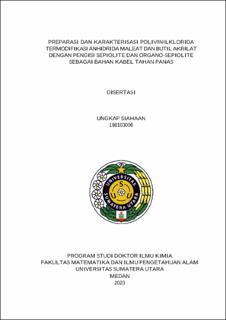Preparasi dan Karakterisasi Polivinilklorida Termodifikasi Anhidrida Maleat dan Butil Akrilat dengan Pengisi Sepiolite dan Organo-Sepiolite sebagai Bahan Kabel Tahan Panas
Preparation and Characterization of Maleic and Butylacrylate Modification Polyvinyl Cloride with Sepiolite and Organo-Sepiolite Fillers as Heat Resistant Cable Materials

Date
2023Author
Siahaan, Ungkap
Advisor(s)
Wirjosentono, Basuki
Nasution, Darwin Yunus
Zuhra, Cut Fatimah
Metadata
Show full item recordAbstract
This research investigates the influence of using magnesium oxide (MgO) and sepiolite fillers in PVC blends and modification with maleic anhydride and butyl acrylate comonomers (AM/BA) on the properties of PVC blends. The results of the study show that the optimal PVC blend (with transparent properties) is obtained with a MgO/sepiolite content of 5 phr. MgO and sepiolite act as matrix strengtheners in PVC at a low concentration of 5 phr and serve as thermal decomposition inhibitors in PVC samples. Modification with AM/BA comonomers forms PVC-grafted-AM/BA gel as a strengthener and poly-(AM/BA)n homopolymer as a plasticizer in PVC resin. The optimum conditions for modifying PVC resin with AM/BA comonomers are with AM content of 10 phr and BA content of 5 phr, as evidenced by several analyses, such as tensile strength values of 8.18 and 6.16 MPa, elongation values of
197.53 and 94.05%, and elastic modulus values of 0.292 and 0.195 MPa. FTIR spectroscopy analysis indicates the binding of AM/BA comonomers in the PVC matrix through single-chain grafting, long-chain grafting, and interpenetration reactions, as shown by absorption peaks of carbonyl groups in AM [-(CO)-O-(OC)-] at wave numbers 1637.78 and 1724.38 cm-1. Similar observations are seen in PVC- g-BA, with absorption peaks for bending and stretching of carbonyl groups in butyl acrylate [-(CO)-O-(C-4H9)] also observed at wave numbers 1627.0 and 1720.50 cm-1. The addition of sepiolite and organo-sepiolite fillers strengthens PVC blends at low concentrations by demonstrating uniform filler particle distribution and good adhesion between the PVC matrix and filler surfaces. Additionally, this addition increases the thermal resistance and glass transition temperature (Tg) from 87.48°C to 94.47°C with sepiolite and 94.56°C with organo-sepiolite in the related PVC blends. The results of this research provide important insights into the development of PVC blends with desired properties, such as high thermal resistance and good adhesion, with the assistance of MgO and sepiolite fillers and AM/BA comonomer modification.
Collections
- Doctoral Dissertations [102]
